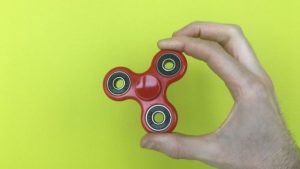Fidget spinners: the new craze in school playgrounds
Forget bottle-flipping and ditch your loom bands, there’s a new craze sweeping school playgrounds.
Fidget spinners were originally developed as a way for children with ADHD or autism to relieve stress.
But in the last few weeks, these palm-sized toys have become the latest “must-have” for almost every school child in the country.
On video-sharing websites like YouTube, vloggers have amassed millions of views from performing tricks with their fidget spinners.
And teachers have reported a huge increase in the number being brought to schools by pupils.
There are reports that some schools have banned the toys, but primary school teacher Danielle Timmons told BBC Radio Scotland that they can have benefits.
“Fidget toys have always been something that we’ve had in schools,” she told The Kaye Adams Programme.
“They’ve only ever really been used by children with additional support needs. In fact, specialists coming into the school recommend them for children and we’ll buy them in for the children that are identified.
“For a long time they’ve always existed but they’ve never been as popular as they seem to be now.
“It’s become a playground toy as well as something that is used by children to stop them from fidgeting.”
There are many different types of fidget spinners but the most popular is a small, three-pronged device.
When it is placed between the thumb and a finger, the user can give it a quick flick to trigger a spin.
Like all the best playground toys, they can be bought for a couple of pounds in a local corner shop – though some are retailing at a much higher price online.
But now some parents have raised concerns that they may be a distraction in the classroom.
Mother-of-three Doreen Boyle said the toys were “infuriating”.
“My youngest, who is 13, appeared with this fidget on Thursday, and it has not left his side.
“I’ve had a house full of little boys all weekend and they’ve all got them, and nobody can talk to you, nobody can have any eye contact with you because they’re all playing with this thing.
“And I can’t believe that they’re not going to affect performance in class.”
Teacher Ms Timmons said that they can aid learning among some children.
However in her class there are strict rules that, if they are being used, they must be kept below the desk and out of the sight of teachers and fellow pupils.
“If a child is going to fidget, they’re going to fidget, there’s nothing you can do to stop them,” she said.
“But these fidget toys are one way of allowing them to fidget without the disruption of the tapping pencils fidgeting, or the tapping feet.
“It’s a much less disruptive way to channel their energies into something else while the teaching is going on. ”
Dr Amanda Gummer, a child psychologist, said the craze was helping to de-stigmatise a toy that was previously only used by children with additional needs.
The fidget toy phenomenon is one that is sweeping the world, not just the UK, according to Richard Gottlieb, founder of US-based consultancy Global Toy Experts.
“It’s spreading globally…and rapidly,” he said.
They are not just confined to the playground however. Adults are also increasingly turning to fidget toys. So what is their appeal?
“I think its the need to fidget manually,” said Mr Gottlieb.
“That’s why some people smoke, others squeeze a rubber ball and even Captain Queeg in the movie the Caine Mutiny manipulated two steel balls in his hand whenever he got worked up.
“I think people in general are pretty stressed out right now by Brexit, the various elections, Donald Trump, Syria, North Korea….you name it.
“So, it is a good time to be selling something that allows an individual to fidget off some stress – particularly at a time when smoking is looked down on.”
He believes the playground craze has been fuelled by a generation of stressed-out children.
“Typically there are people who are influencers, and they can be anything from the coolest kid on the playground to the coolest person in the office, that by simply using a product cause others to do so as well,” he said.
“In this case, however, it took off like crazy and I think it is, again, because adults are anxious but, at least in the US, kids are anxious as well.
“There is just way too much much pressure from parents, too much school work and too much time engaged in adult supervised activities.”









Just seen these as a group of German school children go for a day’s holiday – kept them entertained and looked fascinating.
Thank you for your response Jonathan, I must say I do rather like them myself and can relate to the positive impact of them. I wonder if there could be a place for such things in HE?